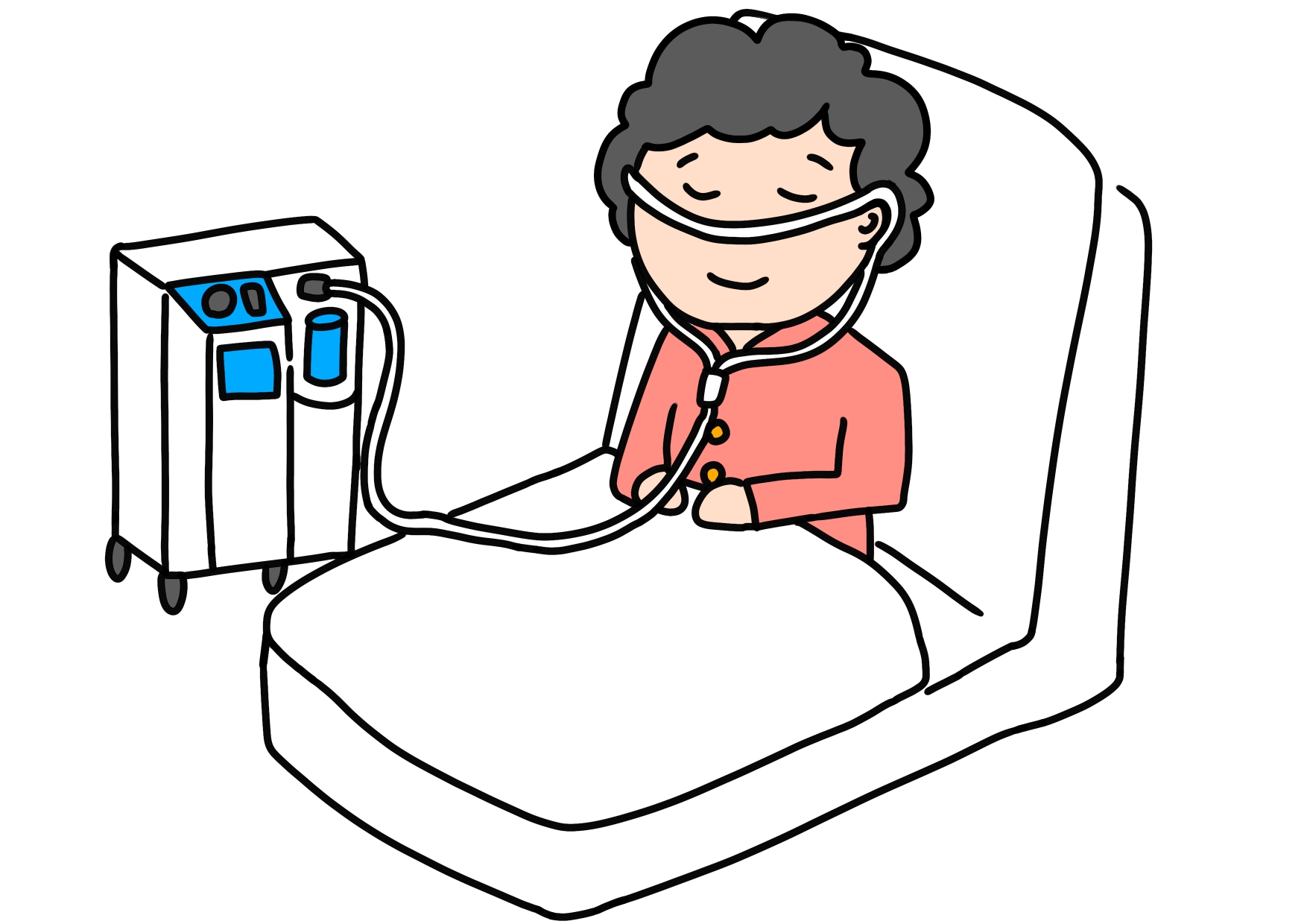第31回介護福祉士国家試験問題より
問題42
Bさん(84歳、男性)は、生活全般に介護を必要としている。ベッド上に仰臥位でいるBさんは、喘息があり、咳込みが続き呼吸が苦しくなり、「楽な姿勢にしてほしい」と訴えた。介護福祉職の対応として、最も適切なものを1つ選びなさい。
1 枕を外して、顔を横に向けて伏臥位にする。
2 枕を重ねて、頭を高くする。
3 左側臥位にして、背中にクッションを当てる。
4 半座位(ファーラー位)にする。
5 オーバーベッドテーブルの上に枕を置いて、上半身を伏せる。
正解は↓

答え 5
ベッド上に仰臥位でいる慢性閉塞性肺疾患(COPD)である可能性が高い利用者への介護福祉職の対応に関する設問です。
1 × Bさんは、喘息があり、咳込みが続き、呼吸が苦しい状態であることから、慢性閉塞性肺疾患である可能性が高いです。慢性閉塞性肺疾患のある人が仰臥位をとると、痰や唾液が喉にたまりやすかったり、背中側の胸郭・肺の動きが制限されて呼吸が苦しくなったりします。一方、伏臥位をとると、仰臥位に比べてたんや唾液が喉にたまりにくく、背中側の胸郭・肺が広がり、呼吸がしやすくなります。ただし、伏臥位も起座位に比べると慢性閉塞性肺疾患のある人にとっての楽の姿勢としては不十分です。また、顔は横に向けているものの、場合によっては窒息する危険性も伏臥位には含まれているため、注意が必要となります。
2 × 頸部が強く後ろに反り返ると、呼吸しづらくなったり、誤嚥の危険性も高まったりします。呼吸しやすくするためには、個々の利用者に応じて枕の高さを調整し、頸部が軽く前屈した姿勢となるようにします。ただし、枕を重ねて頭を高くした結果、利用者によっては頸部が前屈しすぎてしまい、かえって呼吸しづらくなったり、身体の緊張が高まったりするおそれがあります。また、そもそも慢性閉塞性肺疾患のある人が仰臥位をとると、背中側の胸郭・肺の動きが制限されて呼吸が苦しくなったりします。ですから、仰臥位で頭を高くするだけの対応では、慢性閉塞性肺疾患のある人の楽な姿勢としては不十分です。
3 × 仰臥位に比べて側臥位のほうが痰や唾液が喉にたまりにくくなります。ただし、右側臥位になると逆流性食道炎を引き起こす場合もあるため、側臥位になる際には左側臥位にします。また、背中にクッションを当てると背中側の胸郭・肺の動きが制限されて呼吸が苦しくなるおそれがあるため、適切とはいえません。
4 × 半座位(ファーラー位)は、上半身を約45度起こした体位のことで、逆流性食道炎が起こりにくく、仰臥位に比べると呼吸しやすくなります。ただし、背中側の胸郭・肺の動きが制限されやすく、起座位に比べると慢性閉塞性肺疾患のある人にとっての楽な姿勢としては不十分です。
5 〇 Bさんは、喘息があり、咳込みが続き、呼吸が苦しい状態だることから慢性閉塞性肺疾患である可能性が高いです。慢性閉塞性肺疾患の場合、息を吸って、すぼめた口からゆっくりと吐き出す口すぼめ呼吸に加え、起座位をとる必要があります。起座位とは、起座呼吸体位とも呼ばれ、上半身を約90度起こし、オーバーテーブルや机等の上に枕を乗せ、そこにもたれかかるように座らせた姿勢のことです。慢性閉塞性肺疾患のある人が仰臥位をとると、重力の影響で下半身にたまっていた血液が急に心臓に戻り、肺の鬱血が増強され、肺活量が減少し、結果的に呼吸が苦しくなっていまします。ですから、呼吸を楽にするためには、起座位の姿勢をとり、心臓に戻ってくる血液量を減らし、肺活量を増やす必要があります。
英訳
Problem 42
Mr. B (84 years old, male) needs long-term care in all aspects of his life. Mr. B, lying on his bed, had asthma, coughing and difficulty breathing, and he complained, “I want you to be in a comfortable position.” Choose one of the most appropriate responses for long-term care and welfare work.
1 Remove the pillow and turn your face to the side to lie on your stomach.
2 Stack pillows and raise your head.
3 Place the cushion on your back in the left recumbent position.
4 Make it half-sitting (Fowler’s position).
5 Place a pillow on the overbed table and lie down on your upper body.
The correct answer is ↓

Answer 5
This is a question regarding the care and welfare staff’s response to users who are likely to have chronic obstructive pulmonary disease (COPD) lying on the bed.
1 × Mr. B has asthma, coughing continues, and breathing is difficult, so there is a high possibility that he has chronic obstructive pulmonary disease. When a person with chronic obstructive pulmonary disease is in the supine position, sputum and saliva tend to accumulate in the throat, and movement of the thoracic and lungs on the back side is restricted, making breathing difficult. On the other hand, in the prone position, saliva is less likely to collect in the throat than in the supine position, and the chest and lungs on the back side expand, making it easier to breathe. However, the prone position is not as comfortable as the sitting position for people with chronic obstructive pulmonary disease. Also, although the face is turned sideways, there is a risk of suffocation in the prone position, so caution is required.
2 × If the neck is strongly bent back, it may be difficult to breathe and the risk of aspiration may increase. To make it easier to breathe, adjust the height of the pillow according to the individual user so that the neck is in a slightly forward-bent posture. However, as a result of stacking pillows and raising the head, depending on the user, the neck may bend forward too much, making it difficult to breathe and increasing physical tension. In addition, when a person with chronic obstructive pulmonary disease takes the supine position, the movement of the thorax and lungs on the back side is restricted and breathing becomes difficult. Therefore, simply raising your head in the supine position is not enough for a person with chronic obstructive pulmonary disease to have a comfortable posture.
3 × Sputum and saliva are less likely to accumulate in the throat in the lateral decubitus position than in the supine position. However, since it may cause reflux esophagitis when it is in the right lateral decubitus position, it should be in the left lateral decubitus position when it is in the lateral decubitus position. Also, if you put a cushion on your back, the movement of the chest and lungs on the back side may be restricted and you may have difficulty breathing, so it is not appropriate.
4 × Half-sitting position (Fowler’s position) is a position in which the upper body is raised about 45 degrees, and reflux esophagitis is less likely to occur, making it easier to breathe than in the supine position. However, the movement of the thorax and lungs on the back side is likely to be restricted, and it is not sufficient as a comfortable posture for people with chronic obstructive pulmonary disease compared to the sitting position.
5 ○ Mr. B has asthma, coughing continues, and breathing is difficult, so there is a high possibility that he has chronic obstructive pulmonary disease. For chronic obstructive pulmonary disease, it is necessary to take a sitting position in addition to pursed-mouth breathing, in which you inhale and slowly exhale through your pursed mouth. The orthopnea position, also known as the orthopnea position, is a posture in which the upper body is raised about 90 degrees, a pillow is placed on an overtable or desk, and the person sits leaning against it. When a person with chronic obstructive pulmonary disease takes a supine position, the blood that has accumulated in the lower body suddenly returns to the heart due to the influence of gravity, the congestion of the lungs is increased, the vital capacity is reduced, and as a result, breathing is difficult. I am. Therefore, to make breathing easier, you need to take a sitting position, reduce the amount of blood returning to the heart, and increase vital capacity.








コメント